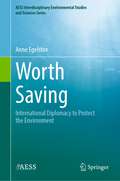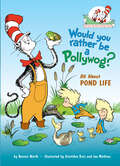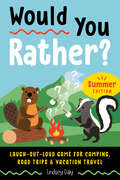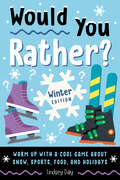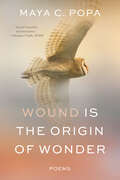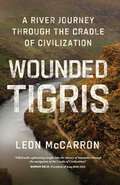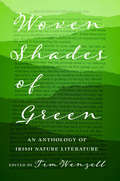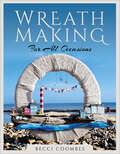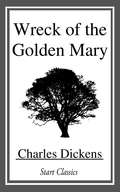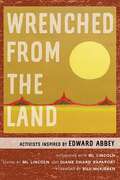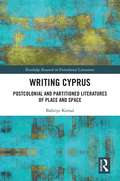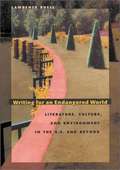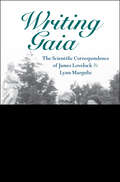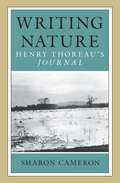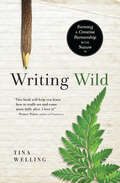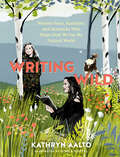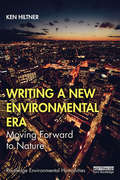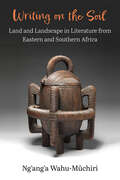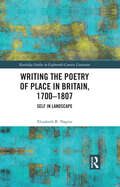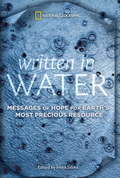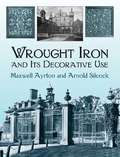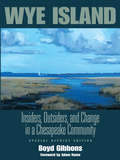- Table View
- List View
Worst-Case Scenarios
by Cass R. SunsteinNuclear bombs in suitcases, anthrax bacilli in ventilators, tsunamis and meteors, avian flu, scorchingly hot temperatures: nightmares that were once the plot of Hollywood movies are now frighteningly real possibilities. How can we steer a path between willful inaction and reckless overreaction? Cass Sunstein explores these and other worst-case scenarios and how we might best prevent them in this vivid, illuminating, and highly original analysis. Singling out the problems of terrorism and climate change, Sunstein explores our susceptibility to two opposite and unhelpful reactions: panic and utter neglect. He shows how private individuals and public officials might best respond to low-probability risks of disaster—emphasizing the need to know what we will lose from precautions as well as from inaction. Finally, he offers an understanding of the uses and limits of cost–benefit analysis, especially when current generations are imposing risks on future generations. Throughout, Sunstein uses climate change as a defining case, because it dramatically illustrates the underlying principles. But he also discusses terrorism, depletion of the ozone layer, genetic modification of food, hurricanes, and worst-case scenarios faced in our ordinary lives. Sunstein concludes that if we can avoid the twin dangers of overreaction and apathy, we will be able to ameliorate if not avoid future catastrophes, retaining our sanity as well as scarce resources that can be devoted to more constructive ends.
Worth Saving: International Diplomacy to Protect the Environment (AESS Interdisciplinary Environmental Studies and Sciences Series)
by Anne EgelstonThis textbook is intended to be used in an upper-level international environmental issues class as part of the American Environmental Studies and Sciences book series. This class is commonly taught at both the undergraduate and graduate level as part of either an environmental studies program, a political science program, or within a policy track of an environmental science program.Given the length of time that negotiations have occurred, a new generation of students and practitioners will need to understand the complex processes that produced many of our environmental treaties. The majority of the students in environmental studies do not have a background in political science. Moving from a political science approach to an interdisciplinary approach will benefit the students by making the material more accessible.As these fields continue to grow and develop, regulatory compliance becomes increasingly important. Thus, this book is aimed at adding a business and industry perspective to this field where appropriate.
Would You Rather Be a Pollywog? All About Pond Life: All About Pond Life (The Cat in the Hat's Learning Library)
by Bonnie WorthLaugh and learn with fun facts about pond animals, algae, metamorphosis, and more—all told in Dr. Seuss&’s beloved rhyming style and starring the Cat in the Hat! &“Near your house is a place of which I am fond. It&’s a body of water that we call a pond.&” The Cat in the Hat&’s Learning Library series combines beloved characters, engaging rhymes, and Seussian illustrations to introduce children to non-fiction topics from the real world! Join the Cat in the Hat and visit a pond to discover: the stages of frog developmentthe difference between complete and incomplete metamorphosishow amphibians spend part of their lives in the water and part on landand much more!Perfect for story time and for the youngest readers, Would You Rather Be a Pollywog? All About Pond Life also includes an index, glossary, and suggestions for further learning. Look for more books in the Cat in the Hat&’s Learning Library series!High? Low? Where Did It Go? All About Animal CamouflageIs a Camel a Mammal? All About MammalsThe 100 Hats of the Cat in the Hat: A Celebration of the 100th Day of SchoolA Great Day for Pup: All About Wild BabiesHappy Pi Day to You! All About Measuring CirclesI Can Name 50 Trees Today! All About TreesFine Feathered Friends: All About BirdsMy, Oh My--A Butterfly! All About ButterfliesOh Say Can You Seed? All About Flowering PlantsInside Your Outside! All About the Human BodyIce is Nice! All About the North and South Poles
Would You Rather? Summer Edition: Laugh-Out-Loud Game for Camping, Road Trips, and Vacation Travel (Would You Rather?)
by Lindsey DalyHilarious questions about the joys of summer for kids who love fun, laughs, and a challenge from the author of the best-selling &“Would You Rather?&” series. School&’s out! Now you can finally relax and have an awesome vacation. And this laugh-out-loud Would You Rather? book is the perfect companion for all your favorite summer activities, whether you&’re at home, at camp, in a tent in the woods, at the pool, or on the road with family and friends. Would You Rather? Summer Edition features:· Thought-provoking scenarios that entertain and challenge kids ages 8-12 to think creatively and speak persuasively. · 160+ "Would You Rather?" questions about campfires, whitewater rafting, pool parties, rock-climbing, bottle rockets, capture the flag, and so much more. · Awesome entertainment for camping, summer camp, and road trips. · Tech-free fun for lazy summer days. · A competitive game for kids and families; who&’s the smartest of them all? Would You Rather? Summer Edition will keep you entertained and laughing in the family car, at the beach, under starry skies, in a camp cabin, or on a cozy hammock in your backyard on warm summer days and nights.
Would You Rather? Winter Edition: Warm Up with a Cool Game About Snow, Sports, Food, and Holidays (Would You Rather?)
by Lindsey DalyHilarious questions about the joys of winter for kids who love fun, laughs, and a challenge, from the bestselling author of Would You Rather? Summer Edition.Cozy up to winter fun with this laugh-out-loud Would You Rather? book—the perfect companion for all your favorite winter activities. Whether you&’re building a snowman, skiing down a snow-covered slope, eating comfort food, or celebrating the solstice, this winter book for kids and their families will keep you warm on chilly winter days.Would You Rather? Winter Edition features:Thought-provoking scenarios that delight and challenge kids ages 8–12 to think creatively and speak persuasively.160+ &“Would You Rather?&” questions about cool sports, snowy weather, holiday celebrations, school vacations, and so much more.Awesome entertainment for holiday get-togethers, hangouts with friends, and snow days.Tech-free fun for winter days spent indoors.A competitive game for kids and families; who&’s the smartest of them all?Would You Rather? Winter Edition will keep you entertained and laughing as you head out to ski or skate, celebrate Christmas or New Year&’s Eve, drink hot chocolate or hot cider, or simply relax after a fun day in the snow.
Wound Is the Origin of Wonder: Poems
by Maya C. Popa“Lyrical, beautiful, and descriptive.” —Mandana Chaffa, BOMB “In ravishing, formally exploratory poems, Maya C. Popa wields the lyric like a reparative scalpel, evoking wonder and woundedness in equal measure.” —Meghan O’Rourke Award-winning poet Maya C. Popa suggests that our restless desires are inseparable from our mortality in this pressing and precise collection. Rooting out profound meaning in language to wrench us from the moorings of the familiar and into the realm of the extraordinary, the volume asks, how do we articulate what’s by definition inarticulable? Where does sight end and imagination begin? Lucid and musically rich, these poems sound an appeal to a dwindling natural world and summon moments from the lives of literary forbearers—John Milton’s visit to Galileo, a vase broken by Marcel Proust—to unveil fresh wonder in the unlikely meetings of the past. Popa dramatizes the difficulties of loving a world that is at once rich with beauty and full of opportunities for grief, and reveals that the natural arc of wonder, from astonishment to reflection, more deeply connects us with our humanity.
Wounded Tigris: A River Journey Through the Cradle of Civilization
by Leon McCarronA fascinating journey down the Tigris River—the lifeblood of human civilization—in search of history and hope. Starting at the source of this storied river, where ancient Mesopotamians and Assyrian kings had their images carved into stone, explorer Leon McCarron and his small team will journey through the Turkish mountains, across north-east Syria and into the heart of Iraq. Along the way, they will pass through historic cities like Diyarbakir, Mosul, and Baghdad. We will meet fishermen and farmers, along with artists, activists, and archaeologists, who rely on the flow of the river. Occasionally harassed by militias, often helped by soldiers, McCarron rode his luck in areas still troubled by ISIS and relied on the generosity of a network of strangers as he follows the river to its end in the Persian Gulf. For readers of Simon Winchester, Erika Fatland, and Kevin Fedarko, Wounded Tigris is the story of what humanity stands to lose with the death of a great river, and what can be done to try to save it.
Woven Shades of Green: An Anthology of Irish Nature Literature
by Tim WenzellWoven Shades of Green is an annotated selection of literature from authors who focus on the natural world and the beauty of Ireland. The anthology begins with the Irish monks and their largely anonymous nature poetry, written at a time when Ireland was heavily forested. A section follows devoted to the changing Irish landscape, through both deforestation and famine, including the nature poetry of William Allingham, James Clarence Mangan, essays from Thomas Gainford and William Thackerary, and novel excerpts from William Carleton and Emily Lawless. The anthology then turns to the nature literature of the Irish Literary Revival, including Yeats and Synge, but also the poetry of many others, and an excerpt from George Moore’s novel The Lake. Part four of the anthology shifts to modern Irish nature poetry, beginning with Patrick Kavanaugh, and continuing with late twentieth-century, early twenty-first-century poetry of Seamus Heaney, Eavan Boland, and others. Finally, the anthology concludes with a section on various Irish naturalist writers, and the unique prose and philosophical nature writing of John Moriarty, followed by a comprehensive list of environmental organizations in Ireland, which seek to preserve the natural beauty of this unique country. Published by Bucknell University Press. Distributed worldwide by Rutgers University Press.
Wreath Making for all Occasions (Make Your Own Ser.)
by Becci CoombesEven a quick walk in the countryside or Sunday stroll along the beach can yield the most interesting and attractive materials for making beautiful decorations for the home. In this book Becci will show you how to form simple wreaths out of foraged elements, with an emphasis on recycling and using sustainable materials. Basic techniques for a variety of seasonal projects are demonstrated, and these can then be used to create smaller garlands, such as napkin rings and candle table centres. Becci focuses on commonly found elements, foraging for plants and foliage and sourcing inspiration from nature; you don’t need to be a trained florist to design gorgeous wreaths and garlands for yourself or your friends. The featured projects will cover wreaths for all seasons, from scented lavender hearts to harvest festival straw circles, and we will explore how to make them from more unusual materials such as pool noodles. The emphasis will be on recycling too, so you will be able to create a garland that can be changed throughout the year to suit your decor and mood.
Wreck of the Golden Mary
by Charles DickensThe Wreck of the Golden Mary is the work of many hands but was originally started by Dickens. The story portrays an amazing voyage around Cape Horn, then north to the coast of California. It takes a stunning turn when the ship strikes an iceberg and passengers and crew languish in lifeboats. Dickens's subtlety of style and picturesque depiction keeps reader rapt till the end.
Wrenched from the Land: Activists Inspired by Edward Abbey
by ML LincolnWrenched from the Land features sixteen interviews with some of the most iconic eco-warriors to put themselves on the line for their beliefs. The activists featured in this book are inspired by the late Edward Abbey, one of America&’s uncompromising and irascible defenders of wilderness. The book includes interviews with Terry Tempest Williams, the late Charles Bowden, Sea Shepherd Society founder Paul Watson, Jack Loeffler, Doug Peacock, Ingrid Eisenstadter, John De Puy, Bob Lippman, Derrick Jensen, Shonto Begay, Ken Sanders, Ken Sleight, the late Katie Lee, Executive Director of the Center for Biological Diversity Kieran Suckling, Earth First! cofounder Dave Foreman, and climate activist Tim DeChristopher.Some were among Abbey&’s closest friends and were the inspiration for his irreverent comedic masterpiece, The Monkey Wrench Gang. Here are mesmerizing stories about how they adapted Abbey&’s monkeywrenching ideas into a radical blueprint for direct action. Their achievements—as ingenious and fierce as the individuals in this book—will encourage readers to discover their own pathways toward positive change.
Writing Cyprus: Postcolonial and Partitioned Literatures of Place and Space (Routledge Research in Postcolonial Literatures)
by Bahriye KemalBahriye Kemal's ground-breaking new work serves as the first study of the literatures of Cyprus from a postcolonial and partition perspective. Her book explores Anglophone, Hellenophone and Turkophone writings from the 1920s to the present. Drawing on Yi-Fu Tuan’s humanistic geography and Henri Lefebvre’s Marxist philosophy, Kemal proposes a new interdisciplinary spatial model, at once theoretical and empirical, that shows the power of space and place in postcolonial partition cases. The book shows the ways that place and space determine identity so it is understood as identification, together these places, spaces and identifications are always in production. In analysing practices towards writing, inventing, experiencing, reading and construction, the book offers a distinct ‘solidarity’ that captures the ‘truth of space’ and place for the production of multiple-mutable Cypruses shaped by and for multiple-mutable selves, ending in a 'differential’ Cyprus, Mediterranean, and world. Writing Cyprus presents not only a nuanced understanding of the actual and active production of colonialism, postcolonialism and partition that dismantles the dominant binary legacy of historical-political deadlock discourse, but a fruitful model for understanding other sites of conflict and division.
Writing For an Endangered World: Literature, Culture, and Environment in the U. S. and Beyond
by Lawrence BuellThe environmental imagination does not stop short at the edge of the woods. Nor should our understanding of it, as Lawrence Buell makes clear in this book that aims to reshape the field of literature and environmental studies. Emphasizing the influence of the physical environment on individual and collective perception, his book thus provides the theoretical underpinnings for ecocriticism.
Writing Gaia: The Scientific Correspondence of James Lovelock and Lynn Margulis
by Bruce Clarke Sébastien DutreuilIn 1972, James Lovelock and Lynn Margulis began collaborating on the Gaia hypothesis. They suggested that over geological time, life on Earth has had a major role in both producing and regulating its own environment. Gaia is now an ecological and environmental worldview underpinning vital scientific and cultural debates over environmental issues. Their ideas have transformed the Earth and life sciences, as well as contemporary conceptions of nature. Their correspondence describes these crucial developments from the inside, showing how their partnership proved decisive for the development of the Gaia hypothesis. Clarke and Dutreuil provide historical background and explain the concepts and references introduced throughout the Lovelock-Margulis correspondence, while highlighting the major landmarks of their collaboration within the sequence of almost 300 letters written between 1970 and 2007. This book will be of interest to researchers in ecology, history of science, environmental history and climate change, and cultural science studies.
Writing Metamorphosis in the English Renaissance
by Susan WisemanTaking Ovid's Metamorphoses as its starting point, this book analyses fantastic creatures including werewolves, bear-children and dragons in English literature from the Reformation to the late seventeenth century. Susan Wiseman tracks the idea of transformation through classical, literary, sacred, physiological, folkloric and ethnographic texts. Under modern disciplinary protocols these areas of writing are kept apart, but this study shows that in the Renaissance they were woven together by shared resources, frames of knowledge and readers. Drawing on a rich collection of critical and historical studies and key philosophical texts including Descartes' Meditations, Wiseman outlines the importance of metamorphosis as a significant literary mode. Her examples range from canonical literature, including Shakespeare's A Midsummer Night's Dream and The Tempest, to Thomas Browne on dragons, together with popular material, arguing that the seventeenth century is marked by concentration on the potential of the human, and the world, to change or be changed.
Writing Nature: Henry Thoreau's Journal
by Sharon CameronAt his death, Henry Thoreau left the majority of his writing unpublished. The bulk of this material is a journal that he kept for twenty-four years. Sharon Cameron's major claim is that this private work (the Journal) was Thoreau's primary work, taking precedence over the books that he published in his lifetime. Her controversial thesis views Thoreau's Journal as a composition that confounds the distinction between public and private--the basis on which our conventional treatment of discourse depends.
Writing Wild: Forming a Creative Partnership with Nature
by Tina WellingAlign Your Creative Energy with Nature’s “Everything we know about creating,” writes Tina Welling, “we know intuitively from the natural world.” In Writing Wild, Welling details a three-step “Spirit Walk” process for inviting nature to enliven and inspire our creativity.
Writing Wild: Women Poets, Ramblers, and Mavericks Who Shape How We See the Natural World
by Kathryn Aalto&“An exciting, expert, and invaluable group portrait of seminal women writers enriching a genre crucial to our future.&” —Booklist In Writing Wild, Kathryn Aalto celebrates 25 women whose influential writing helps deepen our connection to and understanding of the natural world. These inspiring wordsmiths are scholars, spiritual seekers, conservationists, scientists, novelists, and explorers. They defy easy categorization, yet they all share a bold authenticity that makes their work both distinct and universal. Featured writers include: Dorothy Wordsworth, Susan Fenimore Cooper, Gene Stratton-Porter, Mary Austin, and Vita Sackville-WestNan Shepherd, Rachel Carson, Mary Oliver, Carolyn Merchant, and Annie DillardGretel Ehrlich, Leslie Marmon Silko, Diane Ackerman, Robin Wall Kimmerer, and Lauret SavoyRebecca Solnit, Kathleen Jamie, Carolyn Finney, Helen Macdonald, and Saci LloydAndrea Wulf, Camille T. Dungy, Elena Passarello, Amy Liptrot, and Elizabeth Rush Part travel essay, literary biography, and cultural history, Writing Wild ventures into the landscapes and lives of extraordinary writers and encourages a new generation of women to pick up their pens, head outdoors, and start writing wild.
Writing a New Environmental Era: Moving forward to nature (Routledge Environmental Humanities)
by Ken HiltnerWriting a New Environmental Era first considers and then rejects back-to-nature thinking and its proponents like Henry David Thoreau, arguing that human beings have never lived at peace with nature. Consequently, we need to stop thinking about going back to what never was and instead work at moving forward to forge a more harmonious relationship with nature in the future. Using the rise of the automobile and climate change denial literature to explore how our current environmental era was written into existence, Ken Hiltner argues that the humanities—and not, as might be expected, the sciences—need to lead us there. In one sense, climate change is caused by a rise in atmospheric CO2 and other so-called greenhouse gases. Science can address this cause. However, approached in another way altogether, climate change is caused by a range of troubling human activities that require the release of these gases, such as our obsessions with cars, lavish houses, air travel and endless consumer goods. The natural sciences may be able to tell us how these activities are changing our climate, but not why we are engaging in them. That’s a job for the humanities and social sciences. As this book argues, we need to see anthropogenic (i.e. human-caused) climate change for what it is and address it as such: a human problem brought about by human actions. A passionate and personal exploration of why the Environmental Humanities matter and why we should be looking forward, not back to nature, this book will be essential reading for all those interested in the future and sustainability of our planet.
Writing on the Soil: Land and Landscape in Literature from Eastern and Southern Africa (African Perspectives)
by Ng'ang'a Wahu-MuchiriAcross contiguous nation-states in Eastern Africa, the geographic proximity disguises an ideological complexity. Land has meant something fundamental in the sociocultural history of each country. Those concerns, however, have manifested into varied political events, and the range of struggles over land has spawned a multiplicity of literary interventions. While Kenya and Uganda were both British colonies, Kenya's experience of settler land alienation made for a much more violent response against efforts at political independence. Uganda's relatively calm unyoking from the colonial burden, however, led to a tumultuous post-independence. Tanzania, too, like Kenya and Uganda, resisted British colonial administration—after Germany's defeat in World War 1. In Writing on the Soil, author Ng’ang’a Wahu-Mũchiri argues that representations of land and landscape perform significant metaphorical labor in African literatures, and this argument evolves across several geographical spaces. Each chapter's analysis is grounded in a particular locale: western Kenya, colonial Tanganyika, post-independence Tanzania, Zimbabwe, Nairobi, Dar es Salaam, Anam Ka'alakol (Lake Turkana), Kampala, and Kitgum in Northern Uganda. Moreover, each section contributes to a deeper understanding of the aesthetic choices that authors make when deploying tropes revolving around land, landscape, and the environment. Mũchiri disentangles the numerous connections between geography and geopolitical space on the one hand, and ideology and cultural analysis on the other. This book embodies a multi-layered argument in the sphere of African critical scholarship, while adding to the growing field of African land rights scholarship—an approach that foregrounds the close reading of Africa’s literary canon.
Writing the Poetry of Place in Britain, 1700–1807: Self in Landscape (Routledge Studies in Eighteenth-Century Literature)
by Elizabeth R. NapierThis book discusses the intrusion, often inadvertent, of personal voice into the poetry of landscape in Britain, 1700-1807. It argues that strong conventions, such as those that inhere in topographical verse of the period, invite original poets to overstep those bounds while also shielding them from the repercussions of self-expression. Working under cover of convention in this manner and because for each of these poets place is tied in significant ways to personal history, poets of place may launch unexpected explorations into memory, personhood, and the workings of consciousness. The book supplements traditionally political readings of landscape poetry, turning to questions of self-articulation and self-expression in order to argue that the autobiographical impulse is a distinctive and innovative feature of much great eighteenth-century poetry of place. Among the poets under examination are Pope, Thomson, Duck, Gray, Goldsmith, Crabbe, Cowper, Smith, and Wordsworth.
Written in Water
by Irena SalinaWritten in Water is an unforgettable collection of the true stories of people-men and women, politicians and scientists, laymen and experts-sharing in their own words what they have seen and what they have learned in their efforts to bring clean water to all.
Written in Water
by Irena SalinaWritten in Water: Messages of Hope for Earth's Most Precious Resource comprises a collection of essays authored by heroes and leaders in the field of water solutions and innovations--a broad range of people from varied disciplines who have contributed their hearts and minds to bringing awareness to and conserving Earth's freshwater supply. In their own words, authors tell of such tragedies as water slavery, drought, or contamination, as well as their own professional struggles and successes in pursuit of freshwater solutions. Contributors include: Alexandra Cousteau, social environmental advocate and granddaughter of legendary marine scientist Jacques Cousteau; Peter Gleick, environmental visionary and winner of a 2003 MacArthur "genius grant"; Bill McKibben, bestselling author and winner of a Guggenheim fellowship; Sylvia Earle, oceanographer and Time magazine's first "hero for the planet"; and Christine Todd Whitman, former head of the Environmental Protection Agency, along with more than a dozen other notable people.These visionaries' stories touch, surprise, and amaze as they help us see the essential role played by water in our world, our lives, and our future. These are all people who are thinking far beyond the realm of self; they are devoted to creating a better world for all of us.
Wrought Iron and Its Decorative Use
by Arnold Silcock Maxwell AyrtonA superb treasury of decorative wrought iron, this well-illustrated volume presents an informative survey of the ancient craft's practice throughout England. Its history can be traced simply by admiring the crisp black-and-white illustrations of gates, railings, screens, and other elaborately rendered works. 241 black-and-white illustrations.
Wye Island: Insiders, Outsiders, and Change in a Chesapeake Community - Special Reprint Edition
by Boyd GibbonsToday, most of the 2,800 tranquil acres that make up Wye Island are managed by the Maryland Park Service. However, from 1973 to 1974, the island was the site of a raging controversy. A major developer, James Rouse, wanted to build a compact waterfront village that would be surrounded by large estates, protected farms, and wetlands. A boyhood resident of nearby Easton, Maryland, Rouse hoped that the island could avoid the sprawl of unplanned subdivisions that were marring so many other places along the Eastern Shore. Combining history, journalism, character sketches, and sharp sociological insight, Boyd Gibbons presents the conflict over Wye Island in its multiple dimensions - as an example of the emerging community-based activism of the 1960s and 70s, and of a community that, while exercising its right to preserve its identity, denies opportunities for its members to improve their lives through change. In fact, Wye Island proves not to be the environmental David-Goliath struggle that might be expected. For one thing, residents opposed a development plan that can be regarded as an early model for 'smart growth.' And many were no more favorably disposed to a park or preserve than to a planned village. Their interest was in protecting the community from an invasion of immigrants from ethnically diverse Baltimore and Washington, and, where the wealthy were concerned, protecting some very private views of the water. In the end, rich landowners, poor 'natives,' and many recent newcomers opposed the Rouse project - distrusting change, and, above all, fearing 'outsiders.' The special reprint of Wye Island includes a new foreword by distinguished environmental historian Adam Rome, who explores the enduring themes of Wye Island in context of the current debates about land use, development, and sprawl.

